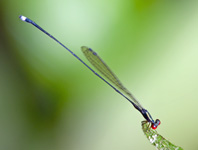Abstract
Microlia Casey, 1910 is a small genus that currently includes twelve species distributed in Australasian and New World regions. Here, two new species of Microlia—M. amici sp. nov. (holotype male deposited in DZUP: Brazil, Paraná State) and M. machadoi sp. nov. (holotype male deposited in DZUP: Brazil, Rio Grande do Sul State)—are described and illustrated. M. amici sp. nov. differs from M. meticola by abdominal segments darker, mesotarsus with 5 segments, tergum VII of male without tubercles, and tergum VIII of male emarginated in posterior margin. While, M. machadoi sp. nov. differs from M. pentamera and M. tetramera by curved spine-like in the posterior margin of tergum III. Additional comments on their pollen-feeders habits that are available from morphological and natural history data, and the distribution of the genus is extended in the New World, now including the first time record for South America.
References
Betz, O., Thayer, M.K. & Newton, A.F. (2003) Comparative morphology and evolutionary pathways of the mouthparts in spore-feeding Staphylinoidea (Coleoptera). Acta Zoologica, 84, 179–238.
http://dx.doi.org/10.1046/j.1463-6395.2003.00147.xBlackwelder, R.E. (1952) The generic names of the beetle family Staphylinidae, with an essay on genotypy. Bulletin of the United States National Museum, 200, iv + 1–483.
Cameron, M. (1923) Descriptions of new species of Staphylinidae from the West Indies, Part II (concluded). Annals and Magazine of Natural History, Sereis 9, 11, 363–400.
Cameron, M. (1943) New species of Staphylinidae (Col.) from Australia and New Guinea. Annals and Magazine of Natural History London, Series 11, 10, 336–354.
Casey, T.L. (1910) New species of the staphylinid tribe Myrmedoniini. In: Casey, T.L. (Ed.), Memoirs on the Coleoptera I. The New Era Printing Company, Lancaster (Pennsylvania), pp. 1–183.
Casey, T.L. (1911) New American species of Aleocharinae and Myllaeninae. In: Casey, T.L. (Ed.), Memoirs on the Coleoptera II. The New Era Printing Company, Lancaster (Penssylvania), pp. 1–245.
DaSilva, S.B. & Caron, E. (2014) The unique Brazilian species of Polylobus Solier (Coleptera: Staphylinidae: Aleocharinae) with a checklist of all species of the genus. Zootaxa, 3811 (2), 226–238.
http://dx.doi.org/10.11646/zootaxa.3811.2.4Erichson, W.F. (1839) Genera et species Staphylinorum insectorum coleopterorum familiae. F. H. Morin, Berlin, viii + 400 pp.
Fauvel, A. (1877) Les staphylinides de l’Australie et de la Polynésie. Annali del Museo cívico di Storia naturale di Genova, 10, 168–298.
http://dx.doi.org/10.5962/bhl.title.49182Gusarov, V.I. (2002) A revision of the genus Microlia Casey, 1910 (Coleoptera: Staphylinidae: Aleocharinae: Hoplandriini). Zootaxa, 34, 1–24.
Hanley, R.S. (2002) Phylogeny and higher classification of Hoplandriini (Coleoptera: Staphylinidae: Aleocharinae). Systematic Entomology, 27, 301–321.
http://dx.doi.org/10.1046/j.1365-3113.2002.00184.xHanley, R.S. (2003) Generic revision of the staphylinid beetle tribe Hoplandriini (Insecta: Coleptera: Staphylinidae: Aleocharinae). Zoological Journal of the Linnean Society, 138, 83–140.
http://dx.doi.org/10.1046/j.1096-3642.2003.00060.xInternational Commission of Zoological Nomenclature. (1999) International Code of Zoological Nomenclature. 4th Edition. London, The International Trust for Zoological Nomenclature, Natural History Museum, 306 pp.
Klimaszewski, J. & Sturm, H. (1991) Four new species of the Oxypodine genus Polylobus Solier (Coleoptera: Staphylinidae: Aleocharinae) collected on the flower heads of some high andean giant rosette plants (Espeletiinae: Asteraceae). The Coleopterists Bulletin, 45, 1–13.
Klinger, R. (1983) Eusphaleren, blütenbesuchende Staphyliniden. 1 Zur Biologie der Käfer (Col., Staphyliniden) Deutsche Entomologische Zeitschrift, 30, 37–44.
http://dx.doi.org/10.1002/mmnd.19830300106Kraatz, G. (1857) Naturgeschichte der Insecten Deutschlands. Erste Abtheilung. Coleoptera. Zweiter Band. Lieferum 5–6. Nicolaische Buchhandlung, Berlin, 312 pp. [pp. 769–1080 pp.]
Lea, A.M. (1910) Australian and Tasmanian Coleoptera inhabiting or resorting to the nest of ants, bees and termites. Proceedings of the Royal Society of Victoria, 23, 116–230.
Lea, A.M. (1912) Australian and Tasmanian Coleoptera Inhabiting or Resorting to the Nest of Ants, Bees and Termites. Proceedings of the Royal Society of Victoria, 25, 31–78.
Newton, A.F. & Thayer, M.K. (2005) Catalog of austral species of Staphylinidae and other Staphylinoidea [online]. Chicago: Field Museum of Natural History [last updated 27 August 2005]. Available from: http://archive.fieldmuseum.org/ peet_staph/db_1b.html (accessed 17 October 2014)
Pace, R. (2003) New or little known Aleocharinae from the Australian Region (Coleoptera, Staphylinidae). In: Daccordi, M. & Giachino, P.M. (Eds.), Results of the zoological missions to Australia of the Regional Museum of Natural Sciences of Turin, Italy. I. Monografie del Museo Regionale di ScienzeNaturali 35, Torino, pp. 111–186.
Peixoto, A.L. (2014) Monimiaceae in Lista de Espécies da Flora do Brasil. Jardim Botânico do Rio de Janeiro. Avaliable from: http://floradobrasil.jbrj.gov.br/jabot/floradobrasil/FB10070 (accessed 19 May 2014)
Solier, A.J.J. (1849) Orden III. Coleopteros. In: Gay, C. (Ed.), Historia Fisica y Politica de Chile. Zoologia. Vol. 4. Paris, C. Gay, pp. 105–508.
Thayer, M.K. (2005) Chapter 11.7. Staphylinidae. In: Beutel, R.G. & Leschen, R.A.B. (Eds.), Handbook of Zoology. Vol. IV. Arthropoda: Insecta, Part 38 Coleoptera. Vol 1. Morphology and Systematics (Archostemata, Adephaga, Myxophaga, Polyphaga partim). De Gruyter, Berlin, pp. 296–345.
Wasmann, E. (1899) Neue Termitophilen und Myrmecophilen aus Indien. Deutsche Entomologische Zeitschrift, 1, 145–169.

